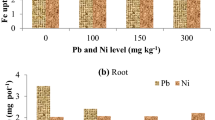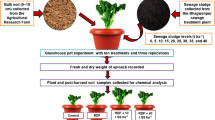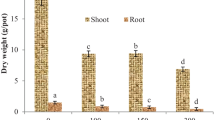Abstract
Purpose
Lead (Pb) pollution is appearing as an alarming threat nowadays in both developed and developing countries. Excessive Pb concentrations in agricultural soils result in minimizing the microbiological activities which leads to the decrease in crop production. A pot experiment was conducted with the purpose to examine the deleterious effect of Pb on microbiological index under spinach cultivation.
Materials and methods
Pb was added to 5 kg soil in each pot (with 6 seeds/pot) using Pb(NO3)2 at the rate of 0, 150, 300, 450, and 600 mg kg−1 with three replications in completely randomized design. All soil microbial, enzymatic, and chemical properties and plant growth parameters and nutrient uptake were measured by standard methods.
Results and discussion
Both soil and plant measured parameters decreased after the addition of Pb (150, 300, 450, and 600 mg Pb kg−1 soil) treatments with the passage of time (from 15 to 60 days) compared with control (CK). However, high Pb levels had more suppressive effect, therefore, highest Pb level (600 mg Pb kg−1 soil) significantly (P < 0.05) decreased the microbial biomass carbon (5.59-fold); microbial biomass nitrogen (N; 11.71-fold); microbial biomass phosphorus (P; 25.1-fold); dehydrogenase (4.02-fold); phosphatase (9.40-fold); urease (9.26-fold); pH (1.40-fold); spinach shoot (2.17-fold) and root (2.54-fold) length; shoot (2.36-fold) and root (2.69-fold) fresh weight; shoot (3.90-fold) and root (3.50-fold) dry weight; chlorophyll content (5.60-fold); carotenoid content (4.29-fold); plant macronutrients uptake, i.e., N (4.38- and 2.97-fold), P (3.88- and 6.58-fold), K (3.88- and 4.6-fold), Ca (6.60- and 6.70-fold), and Mg (5.57- and 4.45-fold); and plant micronutrient uptake, i.e., Zn (2.39- and 3.05-fold), Cu (3.70- and 2.62-fold), Fe (4.13- and 3.23-fold), and Mn (4.17- and 4.09-fold) in spinach shoot and root, respectively. Conversely, highest Pb level, i.e., 600 mg Pb kg−1 soil significantly (P < 0.05) increased the biomass carbon (C)/nitrogen (N) (4.69-fold) and C/P (6.01-fold) ratios, soil extractable Pb (5.87-fold), and Pb uptake in spinach shoot (3.58-fold) and root (4.38-fold), respectively, at the end of the experiment, i.e., day 60.
Conclusions
Pb contamination significantly decreased the soil microbial and enzymatic activities, pH, spinach plant growth, and nutrients uptake in all the samples spiked with Pb. The degree of the influence increased with the increased Pb concentrations and incubation time, showing that Pb threshold is strongly associated with the extent of Pb concentration and time to accumulate. The soil microbial biomass, enzymatic activities, pH, and spinach physiological indices, could be used as a sensitive indicators to reflect environmental stress in soil ecosystems.
















Similar content being viewed by others

Change history
14 March 2019
This article has been retracted by the Editors-in-Chief.
References
Agricultural Statistics of Pakistan (2010–2011) Government of Pakistan, Ministry of Food, Agriculture and Livestock (Economic trade and investment wing). Printing Corporation of Pakistan Press, Islamabad, p. 280
Akmal M, Jianming X (2009) Microbial biomass and bacterial community changes by Pb contamination in acidic soil. J Agric Biol Sci 1:30–37
Akmal M, Jianming X, Zhaojun L, Haizhen W, Huaiying Y (2005) Effects of lead and cadmium nitrate on biomass and substrate utilization pattern of soil microbial communities. Chemosphere 60:508–514
Alef K, Nannipieri P (1995) Methods in applied soil microbiology and biochemistry. Academic, San Diego, p 490
Anderson JM, Ingram JSI (1993) Tropical soil biology and fertility. CAB International, Wallingford, pp 50–79
Bhattacharyya P, Chakrabarti K, Chakraborty A, Tripathy S, Powell MA (2008) Fractionation and bioavailability of Pb in municipal solid waste compost and Pb uptake by rice straw and grain under submerged condition in amended soil. Geosci J 12:41–45
Bindler R (2011) Contaminated lead environments of man: reviewing the lead isotopic evidence in sediments, peat, and soils for the temporal and spatial patterns of atmospheric lead pollution in Sweden. Environ Geochem Health 33:311–329
Brookes PC, Landman A, Pruden G, Jenkinson DS (1985) Chloroform fumigation and the release of soil nitrogen: a rapid direct extraction method to measure microbial biomass nitrogen in soil. Soil Biol Biochem 17:837–842
Buresh RJ, Austin ER, Craswell ET (1982) Analytical methods in N-15 research. Fert Res 3:37–62
Chander K, Dyckmans J, Hoeper H, Joergensen RG, Raubuch M (2001) Long term effects on soil microbial properties of heavy metals from industrial exhaust deposition. J Plant Nutr Soil Sci 164:657–663
Chapman HD, Pratt PF (1961) Methods of analysis for soils, plants and water. University of California, Berkeley
Eldor P (2007) Soil microbiology, ecology, and biochemistry. In: Eldor P (ed) Tercera. Academic, Chennai
Ensink JHJ, Simmons RW, van der Hoek W (2004) Wastewater use in Pakistan: the cases of Haroonabad and Faisalabad. In: Scott CA, Faruqui NI, Raschid L (eds) Wastewater use in irrigated agriculture, confronting the livelihood and environmental realities. CAB International, Wallingford, pp 91–99
Filip Z (2002) International approach to assessing soil quality by ecological related biological parameters. Agri Ecosyst Environ 88:169–174
Gonzales-Quiñones V, Stockdale EA, Banning NC, Hoyle FC, Sawada Y, Wherrett AD, Jones DL, Murphy DV (2011) Soil microbial biomass: interpretation and consideration for soil monitoring. Soil Res 49:287–304
Gopal R, Rizvi AH (2008) Excess lead alters growth, metabolism and translocation of certain nutrients in radish. Chemosphere 70:1539–1544
Hassan W (2013) C and N mineralization and dissolved organic matter potentials of two contrasting plant residues: effects of residue type, moisture and temperature. Acta Agr Scand B-S P. doi:10.1080/09064710.2013.846398
Hassan W, Akmal M, Muhammad I, Younas M, Zahaid KR, Ali F (2013a) Response of soil microbial biomass and enzymes activity to cadmium (Cd) toxicity under different soil textures and incubation times. Aust J Crop Sci 7:674–680
Hassan W, Chen W, Huang Q, Mohamed I (2013b) Microcalorimetric evaluation of soil microbiological properties under plant residues and dogmatic water gradients in Red soil. Soil Sci Plant Nut. doi:10.1080/00380768.2013.845735
Hassan W, Chen W, Cai P, Huang Q (2013c) Oxidative enzymes, the ultimate regulator: implications for factors affecting their efficiency. J Environ Qual 42:1–12
Hesse PR (1972) A textbook of soil chemical analysis. Chemical Publishing Co. Inc, New York
Hussain M, Ahmad MSA, Kausar A (2006) Effect of lead and chromium on growth, photosynthetic pigments and yield components in mash bean [Vigna mungo (L.) Hepper]. Pak J Bot 38:1389–1396
Jackson ML (1973) Soil chemical analysis. Prentice Hall of India Pvt Ltd, New Delhi, p 498
Kandeler E, Gerber H (1988) Short-term assay of soil urease activity using colorimetric determination of ammonium. Biol Fertil Soils 6:68–72
Kandeler E, Mosier A, Morgan J, Milchunas D, King J, Rudolph S, Tscherko D (2006) Response of soil microbial biomass and enzyme activities to the trescient elevation of carbon dioxide in a semi-arid grassland. Soil Biol Biochem 38:2448–2460
Khan S, Cao Q, Zheng YM, Huang YZ, Zhu YG (2008) Health risks of heavy metals in contaminated soils and food crops irrigated with wastewater in Beijing, China. Environ Pollut 152:686–692
Khan S, Hesham A, Qiao M, Rehman S, He JZ (2010) Effects of Cd and Pb on soil microbial community structure and activities. Environ Sci Pollut Res 17:288–296
Kibria MG, Islam M, Osman KT (2009) Effects of lead on growth and mineral nutrition of Amaranthus gangeticus L. and Amaranthus oleracea L. Soil Environ 28:1–6
Komarek M, Ettler V, Chrastny V, Mihaljevic M (2008) Lead isotopes in environmental sciences: a review. Environ Int 34:562–577
Liao M, Chen C, Zeng L, Huang C (2007) Influence of lead acetate on soil microbial biomass and community structure in two different soils with the growth of Chinese cabbage (Brassica chinensis). Chemosphere 66:1197–1205
Lichtenthaler HK, Wellburn AR (1983) Determination of total carotenoids and chlorophyll ‘a’ and ‘b’ of leaf extracts in different solvents. Biochem Soc Trans 11:591–592
Majid NM, Islam MM, Rauf RA (2012) Evaluation of Jelutong (Dyera cotulata) as a phytoremediator to uptake copper (Cu) from contaminated soils. Aust J Crop Sci 6:369–374
Michalska M, Asp A (2001) Influence of lead and cadmium on growth, heavy metal uptake and nutrient concentration of three lettuce cultivars grown in hydroponic culture. Comm Soil Sci Plant Anal 32:571–583
Mishra S, Srivastava S, Tripathi RD, Kumar R, Seth CS, Gupta DK (2006) Lead detoxification by coontail (Ceratophyllum demersum L.) involves induction of phytochelatins and antioxidant system in response to its accumulation. Chemosphere 65:1027–1039
Murtaza G, Ghafoor A, Qadir M, Owens G, Aziz MA, Zia MH, Saifullah (2010) Disposal and use of sewage on agricultural lands in Pakistan: a review. Pedosphere 20:23–34
Nannipieri P, Badalucco L (2003) Biological processes. In: Bembi DK, Nieder R (eds) Processes in the soil-plant system. Modelling concepts and applications. The Haworth Press, Binghamton
Nannipieri P, Ascher J, Ceccherini MT, Landi L, Pietramellara G, Renella G (2003) Microbial diversity and soil functions. Eur J Soil Sci 54:655–670
Nasreen S (2006) Monitoring of surface water, ground water, air and soil in Peshawar basin against time the third dimension. (Unpublished) Ph.D. thesis, Centre of Excellence in Geology, University of Peshawar, Pakistan
Öhlinger R (1996) Biomass-P by fumigation–extraction technique. In: Schinner F, Ohlinger R, Kandeler E, Margesin R (eds) Methods in soil biology. Springer, Berlin, pp 62–64
Olsen SR, Sommers LE (1982) Phosphorus. In: Page AL (ed) Methods of soil analysis. Agronomy no. 9, Part 2. Chemical and microbiological properties, 2nd edn, ASA, Madison, WI, USA. pp. 403–430
Omirou M, Rousidou C, Bekris F, Papadopoulou KK, Mekissoglou-Spiroudi U, Ehaliotis C, Karpouzas G (2011) The impact of biofumigation and chemical fumigation methods on the structure and function of the soil microbial community. Microbial Ecol 61:201–213
Page AL, Miller RH, Keeney DR (1982) Methods of soil analysis-chemical and microbiological properties. Part 2. 2nd edn. Amer Soc Agron (ASA) no. 9, Madison, Wisconsin
Paivoke AEA (2002) Soil lead alters phytase activity and mineral nutrient balance of Pisum sativum. Environ Exp Bot 48:61–73
Rantalainen ML, Torkkeli M, Strömmer R, Setälä H (2006) Lead contamination of an old shooting range affecting the local ecosystem-a case study with a holistic approach. Sci Total Environ 69:99–108
Reimann C, Flem B, Fabian K, Birke M, Ladenberger A, Négrel P, Demetriades J, Hoogewerff A, The GEMAS Project Team (2012) Lead and lead isotopes in agricultural soils of Europe—the continental perspective. Appl Geochem 27:532–542
Robinson BH, Bischofberger S, Stoll A, Schroer D, Furrer G, Roulier S et al (2008) Plant uptake of trace elements on a Swiss military shooting range: uptake pathways and land management implications. Environ Pollut 153:668–676
Rout GR, Samantaray S, Das P (2001) Aluminum toxicity in plants: a review. Agronomie 21:3–21
Salk A, Arin L, Deveci M, Polat S (2008) Special vegetable production. Onur Press, Tekirdag, p 488
Sarfraz MS, Mehdi M, Hassan G, Abbas ST (2007) Metal contamination in nullah dek water and accumulation in rice. Pedosphere 17:130–136
Sharma P, Dubey RS (2005) Lead toxicity in plants. Braz J Plant Physiol 17:35–52
Tandy S, Schulin R, Nowack B (2006) The influence of EDDS on the uptake of heavy metals in hydroponically grown sunflowers. Chemosphere 62:1454–1463
Tiemann KJ, Gardea TJ, Gamez G, Dokken K, Sias S (1999) Use of X-ray absorption spectroscopy and esterification to investigate Cr(III) and Ni(II) ligands in alfalfa biomass. Environ Sci Technol 33:150–154
Van Schouwenberg JCH, Walinge I (1973) Methods of analysis for plant material. Agricultural University Wageningen, Wageningen, The Netherlands
Walker WM, Miller JE, Hassett JJ (1977) Effect of lead and cadmium upon the calcium, magnesium, potassium and phosphorus concentration in young corn plants. Soil Sci 124:145–151
Walkley AJ, Black TA (1934) An estimation of the Degt. Jarett method for determining soil organic matter and a proposed modification of the chromic acid titration. Soil Sci 37:29–38
Waseem K, Nadeem MA (2001) Enhancement of spinach production by varying sowing dates, row spacing and frequency of cuttings. Online J Biol Sci 1:902–904
Wu J, Joergensen RG, Pommerening B, Haussod R, Brookes PC (1990) Measurement of soil microbial biomass C by fumigation–extraction—an automated procedure. Soil Biol Biochem 22:1167–1169
Wyszkowska J, Kucharski J (2000) Biochemical properties of soil contaminated by petrol. Polish J Environ Stud 9:479–485
Zeng LS, Liao M, Chen CL, Huang CY (2007) Effects of lead contamination on soil enzymatic activities, microbial biomass and rice physiological indices in soil–lead–rice (Oryza sativa L.) system. Ecotoxic Envieron Saf 67:67–74
Author information
Authors and Affiliations
Corresponding author
Additional information
Responsible editor: Zucong Cai
This article has been retracted by the Editors-in-Chief. After a thorough investigation carried out by the Higher Education Commission of Pakistan and Muhammad Nawaz Sharif University of Agriculture, Pakistan, it was found that one of the co-authors, Mr. Waseem Hassan, plagiarized sections of this article from Mr. Idrees Haider's masters' thesis that was published in 2009 at PMAS Arid Agriculture University, Rawalpindi, Pakistan.
About this article
Cite this article
Hassan, W., David, J. RETRACTED ARTICLE: Effect of lead pollution on soil microbiological index under spinach (Spinacia oleracea L.) cultivation. J Soils Sediments 14, 44–59 (2014). https://doi.org/10.1007/s11368-013-0802-3
Received:
Accepted:
Published:
Issue Date:
DOI: https://doi.org/10.1007/s11368-013-0802-3



